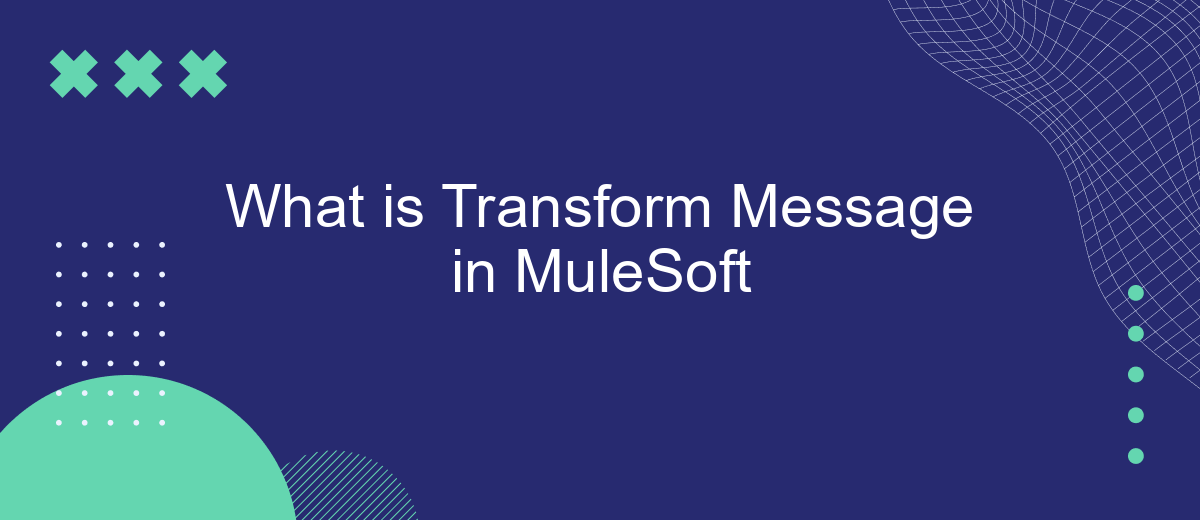Transform Message is a powerful component in MuleSoft's Anypoint Platform that enables developers to easily convert data between different formats and structures. By leveraging DataWeave, MuleSoft's expression language, users can map, filter, and transform data with high precision and efficiency, facilitating seamless integration between diverse systems and applications. This article delves into the functionalities and benefits of using Transform Message in MuleSoft.
Introduction
Transform Message is a powerful feature in MuleSoft that allows developers to manipulate and transform data between different formats and structures. This functionality is essential for integrating various systems and ensuring seamless data flow across applications. By using Transform Message, developers can easily convert data from one format to another, apply business logic, and enrich data as needed.
- Data format conversion (e.g., JSON to XML)
- Data enrichment and validation
- Business logic implementation
- Seamless integration between systems
With tools like MuleSoft's Transform Message, and services such as SaveMyLeads, businesses can streamline their integration processes and automate data workflows. SaveMyLeads, for instance, offers an intuitive platform for connecting various applications and automating lead data transfer, which complements the data transformation capabilities of MuleSoft. Together, these tools help organizations achieve efficient and effective data integration solutions.
Benefits of Transform Message in MuleSoft

Transform Message in MuleSoft offers numerous benefits that streamline the integration process and enhance data transformation capabilities. By allowing developers to easily map, filter, and transform data between different formats and systems, it significantly reduces the complexity of integration projects. This not only accelerates development cycles but also minimizes the chances of errors, ensuring more reliable and consistent data flows across various applications and services.
Additionally, Transform Message in MuleSoft can be seamlessly integrated with third-party services like SaveMyLeads, which automates the process of data capture and lead management. This integration enables businesses to effortlessly synchronize data between their CRM systems and other platforms, ensuring that all leads are accurately tracked and managed. By leveraging these capabilities, organizations can optimize their workflows, improve data accuracy, and ultimately enhance their overall operational efficiency.
How to Use Transform Message in MuleSoft

To effectively use the Transform Message component in MuleSoft, follow these steps to ensure seamless data transformation within your Mule applications.
- First, drag and drop the Transform Message component from the Mule Palette to your flow.
- Next, define the input and output metadata by clicking on the "Define Metadata" button. This helps in mapping the data structure accurately.
- Then, use the DataWeave language to write the transformation logic. DataWeave allows you to easily convert data from one format to another, such as JSON to XML or vice versa.
- Finally, test your transformation by running the flow and verifying the output. Make adjustments to the DataWeave script as needed to achieve the desired results.
For more advanced integrations, you can leverage services like SaveMyLeads, which simplifies the process of connecting various platforms and automating data workflows. This can be particularly useful when dealing with complex data transformations and integrations. By following these steps, you can efficiently use the Transform Message component to handle data transformations in MuleSoft.
Examples of Transform Message in MuleSoft

Transform Message is a powerful feature in MuleSoft that allows developers to convert data from one format to another. This is particularly useful in integration scenarios where different systems communicate using different data formats. For instance, you might need to transform JSON data into XML or vice versa.
Let's consider a few examples to illustrate how Transform Message can be used in MuleSoft. These examples will help you understand the practical applications and the flexibility this feature offers.
- Transforming a JSON payload to XML for a web service call.
- Converting CSV data to JSON for easier manipulation in Mule applications.
- Mapping fields from a database result set to a custom JSON structure.
By leveraging Transform Message, you can ensure seamless data integration between disparate systems. For instance, using services like SaveMyLeads, you can automate the process of capturing and transforming lead data from various sources into a format compatible with your CRM or marketing platform, making your data workflows more efficient and reliable.
Conclusion
In conclusion, the Transform Message component in MuleSoft is a powerful tool that enables developers to efficiently convert and map data between various formats and structures. Its versatility and ease of use significantly enhance the integration process, allowing for seamless communication between disparate systems. By leveraging the DataWeave language, developers can create complex transformations with minimal effort, ensuring that data flows smoothly and accurately through the integration pipeline.
For businesses looking to optimize their integration workflows further, services like SaveMyLeads offer additional capabilities to streamline data integration and automation. SaveMyLeads provides a user-friendly interface and robust functionality, making it easier to connect various applications and automate data transfers without extensive coding. By combining the strengths of MuleSoft's Transform Message component with the automation features of SaveMyLeads, organizations can achieve more efficient and reliable integrations, ultimately driving better business outcomes.
- Automate the work with leads from the Facebook advertising account
- Empower with integrations and instant transfer of leads
- Don't spend money on developers or integrators
- Save time by automating routine tasks
FAQ
What is Transform Message in MuleSoft?
Why is Transform Message important in MuleSoft?
Can I use Transform Message to filter data?
How does Transform Message handle different data formats?
Is it possible to use Transform Message for complex data transformations?
Are you using Facebook Lead Ads? Then you will surely appreciate our service. The SaveMyLeads online connector is a simple and affordable tool that anyone can use to set up integrations for Facebook. Please note that you do not need to code or learn special technologies. Just register on our website and create the necessary integration through the web interface. Connect your advertising account with various services and applications. Integrations are configured in just 5-10 minutes, and in the long run they will save you an impressive amount of time.

